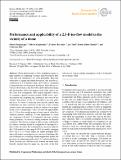Files in this item
Performance and applicability of a 2.5-D ice-flow model in the vicinity of a dome
Item metadata
| dc.contributor.author | Passalacqua, Olivier | |
| dc.contributor.author | Gagliardini, Olivier | |
| dc.contributor.author | Parrenin, Frédéric | |
| dc.contributor.author | Todd, Joe | |
| dc.contributor.author | Gillet-Chaulet, Fabien | |
| dc.contributor.author | Ritz, Catherine | |
| dc.date.accessioned | 2020-01-29T15:30:08Z | |
| dc.date.available | 2020-01-29T15:30:08Z | |
| dc.date.issued | 2016-07-06 | |
| dc.identifier | 266071976 | |
| dc.identifier | db45f1d1-c6c2-4686-814e-4556d14be68a | |
| dc.identifier | 84977668324 | |
| dc.identifier.citation | Passalacqua , O , Gagliardini , O , Parrenin , F , Todd , J , Gillet-Chaulet , F & Ritz , C 2016 , ' Performance and applicability of a 2.5-D ice-flow model in the vicinity of a dome ' , Geoscientific Model Development , vol. 9 , no. 7 , pp. 2301-2313 . https://doi.org/10.5194/gmd-9-2301-2016 | en |
| dc.identifier.issn | 1991-959X | |
| dc.identifier.other | ORCID: /0000-0003-3183-043X/work/68281819 | |
| dc.identifier.uri | https://hdl.handle.net/10023/19383 | |
| dc.description | This project is supported by the Université Grenoble Alpes in the framework of the proposal called Grenoble Innovation Recherche AGIR. | en |
| dc.description.abstract | Three-dimensional ice flow modelling requires a large number of computing resources and observation data, such that 2-D simulations are often preferable. However, when there is significant lateral divergence, this must be accounted for (2.5-D models), and a flow tube is considered (volume between two horizontal flowlines). In the absence of velocity observations, this flow tube can be derived assuming that the flowlines follow the steepest slope of the surface, under a few flow assumptions. This method typically consists of scanning a digital elevation model (DEM) with a moving window and computing the curvature at the centre of this window. The ability of the 2.5-D models to account properly for a 3-D state of strain and stress has not clearly been established, nor their sensitivity to the size of the scanning window and to the geometry of the ice surface, for example in the cases of sharp ridges. Here, we study the applicability of a 2.5-D ice flow model around a dome, typical of the East Antarctic plateau conditions. A twin experiment is carried out, comparing 3-D and 2.5-D computed velocities, on three dome geometries, for several scanning windows and thermal conditions. The chosen scanning window used to evaluate the ice surface curvature should be comparable to the typical radius of this curvature. For isothermal ice, the error made by the 2.5-D model is in the range 0-10ĝ % for weakly diverging flows, but is 2 or 3 times higher for highly diverging flows and could lead to a non-physical ice surface at the dome. For non-isothermal ice, assuming a linear temperature profile, the presence of a sharp ridge makes the 2.5-D velocity field unrealistic. In such cases, the basal ice is warmer and more easily laterally strained than the upper one, the walls of the flow tube are not vertical, and the assumptions of the 2.5-D model are no longer valid. | |
| dc.format.extent | 13 | |
| dc.format.extent | 532443 | |
| dc.language.iso | eng | |
| dc.relation.ispartof | Geoscientific Model Development | en |
| dc.subject | GE Environmental Sciences | en |
| dc.subject | Modelling and Simulation | en |
| dc.subject | Earth and Planetary Sciences(all) | en |
| dc.subject | 3rd-DAS | en |
| dc.subject.lcc | GE | en |
| dc.title | Performance and applicability of a 2.5-D ice-flow model in the vicinity of a dome | en |
| dc.type | Journal article | en |
| dc.contributor.institution | University of St Andrews. School of Geography & Sustainable Development | en |
| dc.contributor.institution | University of St Andrews. Bell-Edwards Geographic Data Institute | en |
| dc.identifier.doi | https://doi.org/10.5194/gmd-9-2301-2016 | |
| dc.description.status | Peer reviewed | en |
This item appears in the following Collection(s)
Items in the St Andrews Research Repository are protected by copyright, with all rights reserved, unless otherwise indicated.

